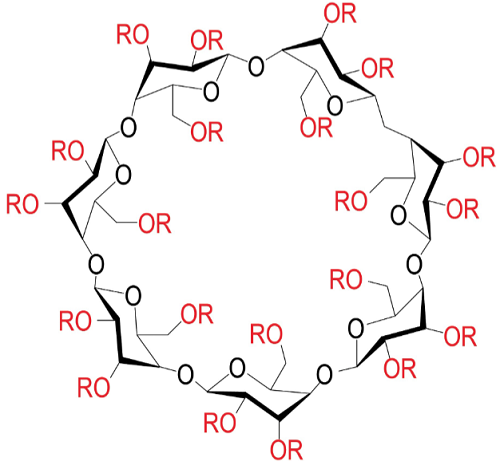| Identification | Back Directory | [Name]
(2-HYDROXYPROPYL)-BETA-CYCLODEXTRIN | [CAS]
128446-35-5 | [Synonyms]
HP-beta-CD
HPBCD/HPCD
CAVASOL(R)W7
Cavasol? W7 HP
2-Hydroxypropyl-&beta
Hydroxypropyl-b-Cyclodextrin
(2-Hydroxypropyl)-beta-cyclode
beta-hydroxypropylcyclodextrin
Hydroxypropyl Betadex (200 mg)
Hydroxypropyl-b-cyclodextrin EP
2-Hydroxypropyl-B-Cyclodextrin
(2-Hydroxypropyl)-β-cyclodextrin
Hydroxypropyl-b-cyclodextrin USP
2-hydroxypropyl-beta-cyclodextirn
Hydroxypropyl-beta-cyclodextrin,97%
(2-HYDROXYPROPYL)-BETA-CYCLODEXTRIN
HYDROXYPROPYL B-CYCLODEXTRIN USP, NF
(2-Hydroxypropyl)-β-cyclodextrin ,97%
β-Cyclodextrin 2-Hydroxypropyl Ethers
Hydroxypropyl-β-cyclodextrin(HP-β-CD)
beta-cyclodextrin,2-hydroxypropylether
(2-Hydroxypropyl)-beta-cyclodextrin ,EP
(2-Hydroxypropyl)-beta-cyclodextrin, 97+%
Hydroxypropyl-beta-cyclodextrin, 97% 25GR
Hydroxypropyl-beta-cyclodextrin, 97% 100GR
HYDROXYPROPYL-BETA-CYCLODEXTRIN, MS = 0. 6
HYDROXYPROPYL-BETA-CYCLODEXTRIN (MS = 0. 8)
(2-HYDROXYPROPYL)-BETA-CYCLODEXTRIN (MS=1.0)
2-HYDROXYPROPYL-B-CYCLODEXTRIN CELLCULTU RE TESTED
(2-Hydroxypropyl)-β-cyclodextrin, avge. MW ca 1340
(2-Hydroxypropyl)-β-cyclodextrin, avge. MW ca 1400
(2-Hydroxypropyl)-^b-cyclodextrin, MW ca 1250-1480
(2-Hydroxypropyl)-^b-cyclodextrin, avge. MW ca 1340
(2-Hydroxypropyl)-^b-cyclodextrin, avge. MW ca 1400
(2-Hydroxypropyl)-beta-cyclodextrin, MW ca 1250-1480
(2-Hydroxypropyl)-beta-cyclodextrin average Mw ~1,380
(2-Hydroxypropyl)-beta-cyclodextrin average Mw ~1,460
(2-Hydroxypropyl)-beta-cyclodextrin average Mw ~1,540
(2-Hydroxypropyl)-beta-cyclodextrin, avge. MW ca 1400
(2-Hydroxypropyl)-beta-cyclodextrin produced by Wacker Chemie AG, Burghausen, Germany | [EINECS(EC#)]
420-920-1 | [Molecular Formula]
C63H112O42 | [MDL Number]
MFCD00069372 | [MOL File]
128446-35-5.mol | [Molecular Weight]
1541.54 |
| Chemical Properties | Back Directory | [Appearance]
White to slightly yellow powder | [Melting point ]
278 °C (dec.)
| [Boiling point ]
400℃ | [density ]
1.05 at 20.3℃ | [refractive index ]
125 ° (C=1, H2O) | [storage temp. ]
2-8°C
| [solubility ]
H2O: 45 % (w/v)
| [form ]
solution (clear, colorless)
| [color ]
White to slightly yellow | [PH]
5.0-7.0 (20g/L in H2O) | [biological source]
synthetic (organic) | [optical activity]
[α]26/D +139°, c = 1 in H2O | [Water Solubility ]
Soluble in water. | [InChIKey]
ODLHGICHYURWBS-FOSILIAISA-N | [LogP]
-4 at 20℃ | [Surface tension]
63.6-65mN/m at 1g/L and 22℃ | [EPA Substance Registry System]
.beta.-Cyclodextrin, 2-hydroxypropyl ethers (128446-35-5) |
| Hazard Information | Back Directory | [Chemical Properties]
White to slightly yellow powder | [Uses]
2-Hydroxypropyl-β-cyclodextrin (HBC) is a widely used modified cyclodextrin, the lipophilic cavity formed by 7 glucose units. Drug solubility in water is greatly enhanced by complexing with 2-Hydroxypropyl-β-cyclodextrin. | [Uses]
enteric coating, sustained release formulations, buccal and transdermal drug delivery | [Uses]
selective estrogen receptor modulator for the prevention of osteoporosis | [Production Methods]
Hydroxypropyl betadex is prepared by the treatment of an alkaline
solution of b-cyclodextrin with propylene oxide. The substitution
pattern can be influenced by varying the pH. Formation of O-6 and
O-2 substituted products is favored by high and low alkali
concentration, respectively. The mixture of products produced
may be refined by preparative chromatography. | [General Description]
(2-Hydroxypropyl)-β-cyclodextrin, a hydroxyalkyl derivative, finds application as a formulation vehicle that is used to enhance the solubility of the drugs in aqueous solutions for the successful delivery of medical agents to biological systems. It is generally employed as a substitute for α-, β- and γ-cyclodextrins. | [Pharmaceutical Applications]
Hydroxypropyl betadex has been widely investigated in pharmaceutics
and has principally been used as a solubilizer for
hydrophobic molecules in oral liquids,oral solids, parenterals,
pressurized metered dose inhalers, dry powder inhalers,
and topical formulations. It has also been shown to act as a
stabilizer during processing and storage of formulations.
Hydroxypropyl betadex inclusion complexes have been reported
to show mechanical properties distinct from the pure materials.
The reported advantage of hydroxypropyl betadex over unsubstituted
b-cyclodextrin is its greater water solubility. | [Biological Activity]
Cell treatment with HPβCD results in the activation of the transcription factor EB, a master regulator of lysosomal function and autophagy, and in the enhancement of the cellular autophagic clearance capacity. HPβCD administration promotes transcription factor EB-mediated clearance of proteolipid aggregates that accumulate due to inefficient activity of the lysosome-autophagy system in cells derived from a patient with a lysosomal storage disorder. Interestingly, HPβCD-mediated activation of autophagy was found not to be associated with activation of apoptotic pathways[2].
| [Side effects]
2-Hydroxypropyl-β-cyclodextrin (HP-beta-CD) has been shown to be well tolerated in humans, with the main adverse event being diarrhoea and there have been no adverse events on kidney function, documented to date[1]. | [Safety]
The pharmaceutical toxicology of hydroxypropyl betadex has been
reviewed, and in general, the material was found to be of low
toxicity. It has been suggested that hydroxypropyl betadex may
have a synergistic toxic effect with, for example, carcinogens, by
increasing their solubility and thus bioavailability. | [storage]
Store in well-closed containers. | [Regulatory Status]
Included in oral and parenteral medicinal products. Included in an
injectable preparation licensed in the UK for intramuscular or
intravenous administration. | [References]
[1] Sarah Gould, Robert C. Scott. “2-Hydroxypropyl-β-cyclodextrin (HP-β-CD): A toxicology review.” Food and Chemical Toxicology 43 10 (2005): Pages 1451-1459.
[2] Wensi Song. “2-Hydroxypropyl-β-cyclodextrin promotes transcription factor EB-mediated activation of autophagy: implications for therapy.” The Journal of Biological Chemistry (2014): 10211–22.
|
| Safety Data | Back Directory | [Safety Statements ]
24/25 | [WGK Germany ]
3
| [RTECS ]
GU2293332
| [TSCA ]
Yes | [HS Code ]
29400090 | [Toxicity]
mouse,LD,intravenous,> 5gm/kg (5000mg/kg),Journal of Pharmaceutical Sciences. Vol. 84, Pg. 1223, 1995. |
| Questions And Answer | Back Directory | [Structure]
2-Hydroxypropyl-β-cyclodextrins (HPβCDs) are synthesized by condensation between β-cyclo-dextrin (βCD) and propylene oxide. Structure of 2-hydroxypropyl-β-cyclodextrin (HPβCD) where R = H or CH2-CHOH-CH3 is shown below. There are 21 (red) hydroxyl groups on βCD, which are potential substitution sites for the condensation reaction with propylene oxide to yield various species of HPβCD with different degrees of substitution depending upon how many sites are substituted[3].

|
|
|